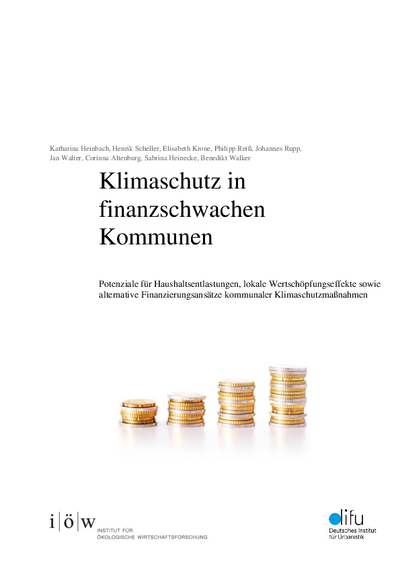Climate action in financially weak municipalities Potentials for budget relief, local value-added effects and alternative means of finance of municipal climate protection measures
In its Climate Action Plan 2050, Germany has set the goal to cut national greenhouse gas emissions by 40% until 2020 and by 80-95% until 2050, compared to 1990 levels. To reach these reduction targets, action is required at all political levels. As places of residence and business locations, municipalities play a key role at this. However, climate action is still among the voluntary tasks of municipalities. Its execution is therefore highly dependent on human and financial resources of the respective city or municipality. This issues a challenge particularly to financially weak municipalities, as they often struggle to even balance their annual budget by own funds. The project ‘Between value added and budgetary restrictions: Qualifying financially weak municipalities for climate protection measures’ aimed at identifying strategies to reduce existing budgetary and supervisory restrictions and signposting alternative approaches to implementing climate protection measures in financially weak municipalities. The project was funded by the Federal Ministry for the Environment, Nature Conservation and Nuclear Safety (BMU) within the National Climate Initiative (NCI).
This publication conflates key results from different analyses within the project. First, a legal understanding of the term ‘financial weakness’ is presented, as well as the budgetary and supervisory framework and restrictions that municipalities face when implementing climate protection measures. Furthermore, the paper describes the challenges municipalities experience during the design and introduction of climate action measures. These issues mostly result from the strained budgetary situation, but do go beyond that. In addition, the authors address the question of possible benefits from municipal climate protection activities – besides the primary goal of reduced greenhouse gas emissions. Here, they focus on cost savings as well as local value-added and employment effects. Besides that, focus also lies on alternative financial instruments beyond classical approaches such as loans and funding schemes on the state and federal state level. This covers a description of the instruments, their advantages and disadvantages as well as their applicability to fund climate protection measures in financially weak municipalities.



